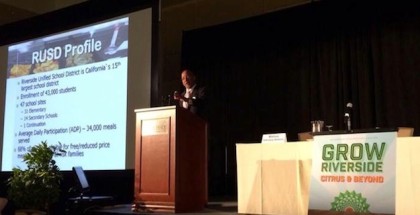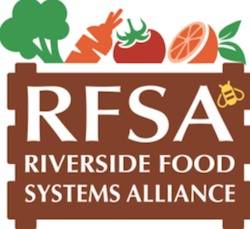L.A. Food Policy Council Outlines Path to Fresh Food for All in the City of Angels
February 17, 2016 | AJ Hughes

A blighted vacant lot is seen in Los Angeles. Through urban agriculture incentive zones, the Los Angeles Food Policy Council wants to see more vacant blighted land transformed into thriving urban farms and gardens. (Photo courtesy Camille de la Vega/Los Angeles Food Policy Council)
Imagine a world-class metropolis where people take their relationships with food so seriously that all citizens enjoy access to farmers’ markets. The notion of food waste is obsolete (instead, think food capital). Farms and gardens thrive where vacant lots once languished and the streets are alive with an astounding variety of food vendors.
That’s a vision that the Los Angeles Food Policy Council (LAFPC) is working hard to make a reality in the City of Angels. To make food access more equitable for all, LAFPC is stressing four equity initiatives which focus on urban agriculture incentive zones, sidewalk food vending, food waste recycling and compost, and accessible farmers’ markets.
“We want to create a good food region,” says LAFPC executive director Clare Fox. “We want to have a sustainable and equitable food system, with expanded access to underserved communities.”
This sounds great, but how to do it? According to Fox, the answer to these challenges can come through effective policy. Like other major cities, Los Angeles has its share of vacant lots and urban blight. But a California state law passed in 2014 enables municipalities to lower taxes on urban lands used for agriculture.
Last fall, Los Angeles County Supervisor Mark Ridley-Thomas proposed an Urban Agriculture Incentive Zone program for the county. Then, the Los Angeles County Board of Supervisors voted to advance this plan to reduce property taxes on vacant lots used for food production.
But to counteract the possibility of property tax money lost, Ridley-Scott proposed a rollout of the program. More details were needed, and a report on the program’s feasibility is expected in March of this year.
Fox feels more urban agriculture will lead to healthier neighborhoods, both economically and concerning nutrition. More vacant land for growing food is in line with LAFPC’s Healthy Neighborhood Market Network, an initiative that empowers neighborhood markets and corner stores in underserved areas to sell nutritious fare.
In 2012, The LAFPC developed the Good Food Purchasing Policy, which, once adopted by institutions, holds them accountable in five key areas: local economies, environmental sustainability, valued workforce, animal welfare, and nutrition. The City of Los Angeles and the Los Angeles Unified School District have adopted this policy, and Fox continues to search for more major institutions to adopt it.
“We’re looking for a big fish—perhaps Los Angeles County or one of Los Angeles’s major universities.”
But securing a greater number of major stakeholders and initiating more policy doesn’t meet every challenge, namely the need to reach out to those on the margins.
“How can we be more inclusive, and include those impacted by injustices?” Fox asks.
Among those Fox refers to are sidewalk food vendors, who can sell legally in only some Los Angeles County municipalities, such as Pasadena, and in special sidewalk vending districts. She says these businesspeople face not only a tangled web of laws and regulations but also a social stigma.
“There are 50,000 sidewalk vendors in Los Angeles, but not all sell food,” says Fox. “These are entrepreneurs who could not find employment in the formal economy.”
Fox says that many food vendors are criminalized for merely trying to make a living. They face competition with brick-and-mortar stores. Fox sees a class-based notion of what people want to see in the streets of a major American city.
Los Angeles city officials and other groups have been pushing to make street vending legal. Recognizing the reality of legitimate health and other concerns, LAFPC remains a staunch advocate for sidewalk food vending in Los Angeles, and would like to see the implementation of a citywide permitting program.
“Street vendors make the streets livelier, and they are part of the economy,” Fox says.
The LAFPC is also working to make farmers’ markets in the city more accessible to all, regardless of income. Even though the majority of farmers’ markets in the City of Los Angeles (and Los Angeles County) accept EBT/WIC, the Council would like to see universal acceptance at all city and county farmers’ markets. And in line with urban agriculture incentive zones, LAFPC is working to increase the number of farmers’ markets in the city and county, especially in food deserts.
Finally, the LAFPC is working not only to reduce food waste but to redefine it. According to Fox, a third of waste in Los Angeles is food and organic material, and more than 100 tons of food goes to the landfill each year. By working together with Zero Waste LA (ultimate goal is 90 percent waste utilization) and other initiatives, Fox and her colleagues would like to see edible food eaten, and nonedible food go to the compost heap or be utilized in other ways. Then, the notion of food as waste becomes obsolete.
This article originally appeared on Seedstock.com: http://seedstock.com/2016/02/17/fresh-food-in-every-neighborhood-food-policy-council-outlines-path-to-equity-in-the-city-of-angels/











Submit a Comment